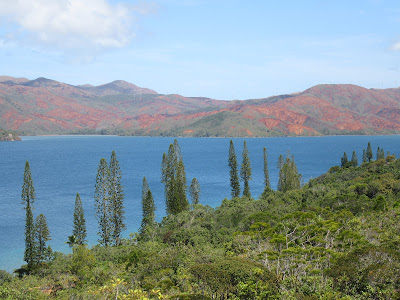Grande Terre: Noumea
and the Bay of Prony
Culture shock!
After three months
of feeling at home in small villages, barefoot and without
electricity, we arrived in Noumea: capital of New Caledonia,
and the most cosmopolitan city in the South Pacific island nations. The waterfront
market sells fine cheese and olives rather than taro and cassava;
food stalls make crepes to order, and one is never far from a pastry
shop. New Caledonia is still colonized by France; for better and for
worse, it shows.
Once again our
arrival timing was fortuitous, just in time for the 30th annual Carnival of Noumea--a Mardi Gras-style parade with 1200 stunningly festooned participants (photo above) and a fireworks
display worthy of any major U.S. city on the 4th of July.
With a European feel
comes European prices, so we didn’t spend much time in the capital.
A few scenes from our days there:
The Tjibaou Cultural
Center, in honor of the Kanak pro-independence leader assassinated in
1989, is an architectural masterpiece that houses traditional
and modern Kanak art.
The tall curved
structures evoke both Kanak huts and graceful pines.
 |
| On the outer grounds are traditional carved statues and lengths of fabric tied to posts. A gift of fabric is the standard offering from guests to hosts in Kanak culture. |
 |
| Carving is still the predominant art form, especially of intricate symbolic designs on large pieces of wood |
Outside of the city, the rest of Grande Terre—and it really is a very Large (Is)Land—is sparsely populated. It’s also a remarkably dry island, more akin to Australia (almost 800 miles to the west) than to lush Vanuatu (about 250 miles to the east).
We took some nice hikes in the Bay of Prony, on the far south end of Grande Terre. The landscape is
characterized by red
earth and dense scrub vegetation, occasionally dotted by araucaria
pines.
 |
| Remains: there is a great deal of mining, particularly of nickel, on Grande Terre |












